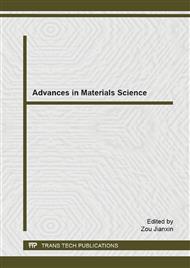[1]
C.Q. Huang, Applications and prospects of aluminum and aluminum alloy in cable industry, China Metal Bulletin. 34 (2012)16-19.
Google Scholar
[2]
Z.M. Ling, The executable standardization for the selection of aluminum alloy cable, Architecture electric. 5 (2011) 240-241.
Google Scholar
[3]
Y.W. Du, Application of aluminum alloy cables in construction engineering, Architecture electric. 5 (2010) 42-45.
Google Scholar
[4]
C.Q. Huang, Prospects of metal conductor saving copper with aluminum, in China, Eng. Sci. 10 (2012) 4-9.
Google Scholar
[5]
Y. Ren, K.S. Bian, Handbook of industrial and civil power distribution design, Chinese Power Press, Beijing, (2005).
Google Scholar
[6]
C. Limmaneevichitr, W. Eidhed, Novel technique for grain refinement in aluminum casting by Al-Ti-B powder injection, Mater. Sci. Eng. A, 355(2003) 174-179.
DOI: 10.1016/s0921-5093(03)00061-3
Google Scholar
[7]
Z.F. Zhu, Y.F. Lan, Research status and development trend of grain refinement of aluminum and its alloy, Foundry equipment research, 2(2004) 51-54.
Google Scholar
[8]
Y.J. Chen, Q.Y. Xu, T.Y. Huang, Research progress on grain refinement of aluminum alloy, Materials review, 12 (2006) 57-61.
Google Scholar
[9]
M.M. Guzowski, G.K. Sigworth, D.A. Senterner, The role of boron in the grain refinement of aluminum with titanium. Metall. Mater. Trans. A, 18(1987) 603-619.
DOI: 10.1007/bf02649476
Google Scholar
[10]
P.S. Mohanty, J.E. Gruzleski, Grain refinement mechanisms of hypoeutectic Al-Si alloys, Acta Mater., 9 (1996) 3749-3760.
DOI: 10.1016/1359-6454(96)00021-3
Google Scholar
[11]
M. Johnsson, L. Backerud, G.K. Sigworth, Study of the mechanism of grain refinement of aluminum after additions of Ti and B containing master alloys, Metall. Mater. Trans. A, 24A(1993) 481-491.
DOI: 10.1007/bf02657335
Google Scholar
[12]
T.E. Quest, A.L. Greer, The effect of the size distribution of inoculant particles on cast grain size in aluminium alloys, Acta Mater., 52(2004) 3859-3868.
DOI: 10.1016/j.actamat.2004.04.035
Google Scholar
[13]
C. Limmaneevichitr, W. Eidhed, Fading mechanism of grain refinement of aluminum-silicon alloy with Al-Ti-B grain refiners, Mater. Sci. & Eng., A349(2003) 197-206.
DOI: 10.1016/s0921-5093(02)00751-7
Google Scholar
[14]
Y. N. Dai, Binary phase diagram. Science Press, Beijing, (2009).
Google Scholar
[15]
T. Wang Z.N. Chen, H.W. Fu, et al., Grain refinement mechanism of pure aluminum by inoculation with Al-B master alloys, Mater. Sci. &Eng., A549(2012) 136-143.
DOI: 10.1016/j.msea.2012.04.019
Google Scholar


